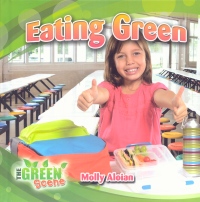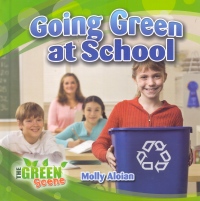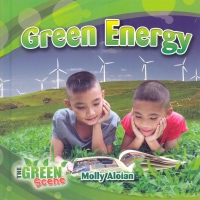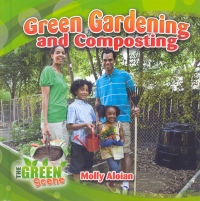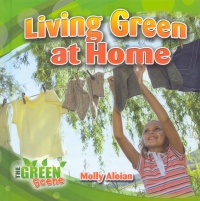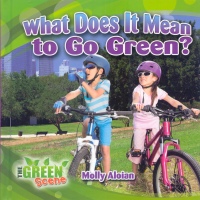| ________________
CM . . .
. Volume XX Number 15. . . .December 13, 2013
excerpt:
Designed to encourage youngsters to become more environmentally conscious and to develop lifelong eco-friendly habits, “The Green Scene” series provides many helpful tips and shows kids how their actions at home, at school and in their community can have a positive impact on the Earth’s resources. There is a fair bit of repetition among the titles- similar information, similar tips (e.g. unplug electronics when they are not in use, don’t let the water run while brushing your teeth, take a litter-free lunch to school) and similar photographs-so it is necessary only to purchase a couple of titles in order to get all of the information. In fact, all of the facts could have been presented in a single volume without it being unwieldy. The text contains just enough information for the target audience and is printed in a large, simple font. Text boxes, entitled “Take Action”, offer food for thought and suggestions for related activities while plenty of color photographs illustrate the concepts. There are a couple of instances of poorly worded sentences. For example, in Green Energy, a photo caption reads, “Salmon are one example of wildlife that a dam built on a river can have a large impact on.” Perhaps it would have been better to say, “A dam built on a river can have a large impact on wildlife such as salmon.” A table of contents, a glossary, a brief index, and a list of books and web sites for further research are included. Some of the web sites provide instructions for small projects and/or activities. Eating Green encourages readers to lessen the impact that food choices have on the environment, especially since more fossil fuels are burned when food has to travel great distances to reach the grocery store. Readers should “buy local”, support farmers’ markets, read food labels in order to find out how far away their food has travelled, avoid food grown with pesticides, produced in a factory or having too much packaging, and should buy organic foods. (Though the idea of buying organic is sound, young readers are not the ones who are paying the household grocery bills- e.g. it is fine to state that organic foods are better than non-organic, but it is also true that these foods generally cost more and many families would be hard-pressed to purchase them on a regular basis.) A family challenge to eat local foods for an entire month will likely result in some interesting discussion and problem-solving. Going Green at School provides information about conserving energy and reducing the amount of garbage that is thrown out. Ideas such as recycling paper, writing on both sides of the paper, using reusable water bottles, packing a litter-free lunch, unplugging electronics when they are not in use, turning the classroom lights off on a sunny day, and walking, biking or skateboarding to school are presented. One interesting suggestion is to purchase environmentally-friendly school supplies such as notebooks made from recycled paper, biodegradable pens, acid-free glue sticks, and pencils made from recycled wood. In Green Energy, readers will learn the difference between renewable and non-renewable resources and how the burning of fossil fuels contributes to global warming. This title lists the pros and cons of various types of energy, one example being nuclear energy which, on the plus side, is reliable, easy to produce, and does not emit greenhouse gases, but, on the minus side, produces dangerous, poisonous waste that is difficult to store. Green energy, produced by the sun, wind, water or biomass, is explained in kid-friendly terms. Some readers might not have heard of biomass before- the energy that comes from corn, straw, scrap wood, manure and grass clippings. Green gardening is defined as planting and growing a healthy garden without the use of chemical pesticides or fertilizers. It can be done in a vegetable bed, in window boxes or even in small containers on a patio or balcony. Green Gardening and Composting shows readers how easy it is to grow gardens, collect rain water, and compost, and the book offers examples of pollution-free alternatives to pesticides. Natural pest deterrents, such as crushed eggshells, garlic, cayenne, milk and hot pepper sauce, are inexpensive, readily available and easy to use. Living Green at Home explains how readers can conserve energy and reduce, reuse and recycle in every room of the house. From homemade cleaning solutions to using energy-efficient lightbulbs, from drying clothes on an outdoor clothesline instead of in the dryer, to purchasing furniture at second-hand shops and restoring it, and having yard sales or donating gently-used clothing to thrift shops, this book is full of practical ideas to help children develop good habits and environmental stewardship. Finally, What Does It Mean to Be Green? provides a general overview of the entire series. The three Rs - reduce, reuse, recycle- are mentioned, as are the reasons why people need to take a more active role in caring for the environment and protecting natural resources such as trees and water. In this title, readers will also learn about Earth Day, held annually in April, and Earth Hour, during which people are encouraged to turn off their lights for one hour on a specific day in March. Generally, these books contain some good information, but, as noted earlier, it is not necessary to purchase the entire series. Recommended. Gail Hamilton is a former teacher-librarian in Winnipeg, MB.
To comment
on this title or this review, send mail to cm@umanitoba.ca.
Copyright © the Manitoba Library Association. Reproduction for personal
use is permitted only if this copyright notice is maintained. Any
other reproduction is prohibited without permission.
NEXT REVIEW |
TABLE OF CONTENTS FOR THIS ISSUE
- December 13, 2013.
AUTHORS |
TITLES |
MEDIA REVIEWS |
PROFILES |
BACK ISSUES |
SEARCH |
CMARCHIVE |
HOME |
